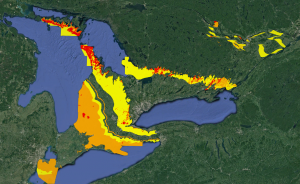Difference between revisions of "Hydrogeology hub"
Jenny Hill (talk | contribs) (Created page with "Welcome") |
Jenny Hill (talk | contribs) m (→See also) |
||
| (6 intermediate revisions by the same user not shown) | |||
| Line 1: | Line 1: | ||
__NOTOC__ | |||
The Conservation Authorities Geoscience Group have prepared a guidance document which attempts to standardize the hydrogeological study requirements for development applications made to Conservation Authorities. It is a helpful guide for all low impact development applications which include [[infiltration]]. | |||
It is provided with the caveat that not all sections or content are necessary or appropriate for every case. Pre-consultation with your Conservation Authority and municipality is strongly recommended in all cases. | |||
'''[http://www.lsrca.on.ca/Shared%20Documents/permits/hydrogeological%20_guidelines.pdf?pdf=Hydrogeological-Guidelines Hydrogeological Assessment Submissions Conservation Authority Guidelines for Development Applications]''' | |||
==Infiltration== | |||
The Ministry of the Environment are preparing advice on where and when to infiltrate rainwater and stormwater. | |||
Things to be mindful of are: | |||
===Pollution hotspots=== | |||
===Karst=== | |||
{{:Karst}} | |||
==See also== | |||
*[[Groundwater]] | |||
*[[Infiltration]] | |||
---- | |||
Latest revision as of 21:14, 8 March 2018
The Conservation Authorities Geoscience Group have prepared a guidance document which attempts to standardize the hydrogeological study requirements for development applications made to Conservation Authorities. It is a helpful guide for all low impact development applications which include infiltration.
It is provided with the caveat that not all sections or content are necessary or appropriate for every case. Pre-consultation with your Conservation Authority and municipality is strongly recommended in all cases.
Infiltration[edit]
The Ministry of the Environment are preparing advice on where and when to infiltrate rainwater and stormwater. Things to be mindful of are:
Pollution hotspots[edit]
Karst[edit]
Karst formations are found in areas along the Niagara Escarpment, including the Bruce Peninsula, the Guelph/Rockwood/Elora area of Wellington County and in portions of eastern Ontario[1].
Karst formations, in which there are undetected sinkholes, trenches and caverns, can be dangerous[edit]
There is no one formula for defining a hazardous area associated with karst formations. Defining the “area of provincial interest” is a site-specific process. The size, extent and severity of the hazards depend on local conditions[2]. Karst formation character and size depends on the pH of the infiltrating water, the rate at which the rock dissolves, number of fractures and fissures in the rock, distance the water will percolate from surface to water table and the presence of impermeable layers above or below the limestone/dolomite layers.
Karst formations can also be significant recharge zones for municipal supply aquifers[edit]
For example, the City of Guelph, whose drinking water supply is wholly groundwater, is known to be a direct recipient of significant recharge through the areas karst formations.
See also[edit]
- ↑ Ontario Ministry of Northern Development and Mines. Karst. https://www.mndm.gov.on.ca/en/mines-and-minerals/applications/ogsearth/karst. Published 2017. Accessed October 17, 2017.
- ↑ Ontario Ministry of Natural Resources. Understanding Natural Hazards.; 2001. http://www.trentu.ca/iws/documents/GLSLRS_UnderstandingNaturalHazard_Intro.pdf. Accessed October 17, 2017.
